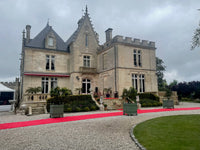Bordeaux Third Growth Classified Châteaux Explained Just in Time for the 2020 Bordeaux en Primeur Futures

Bordeaux Third Growth Classified Châteaux
If you read our post on the First Growths of Bordeaux, you learned about the 1855 classification that put the Châteaux of the left bank in a hierarchy from first to fifth growths. The rankings were largely based on the prices that the wines were being sold for at the time. The theory behind basing the ranking on the price was that the highest quality wines would fetch the highest prices. There are 15 Châteaux in total that are ranked at the Third Growth level.

The Third growths (Troisième Cru in French) provide excellent value to Bordeaux consumers. You are still getting classified wine without paying the extremely high premiums that you would pay for the first and second growths. There are a few notable exceptions to this, with Château Palmer regularly priced well above the majority of the second growths.
What are the Third Growths?
Château La Lagune, Haut-Medoc
This Château dates back to the early 1600s with a long and tumultuous history. The Château itself took nearly two decades to complete construction. In the mid-’50s, the large majority of the vineyard was permanently damaged to frost, requiring replanting. Eventually, in the ’60s the estate was sold to the Ducellier family of Champagne Ayala, both of which were then sold to the Frey family in 1999. Caroline Frey is currently running the estate with her aim set high on what she will be able to achieve. Caroline also manages the historic Paul Jaboulet Aine estate in Hermitage.
Château Lagrange, St-Julien
The oldest documentation of Château Lagrange dates back to 1631. In the early 1800s, the estate was owned by the Baron of Brane, the same owner of Brane Cantenac and Brane Mouton (known today as Mouton Rothschild). The estate once boasted 280 hectares planted under vine, through its history this has sensibly been downsized. Lagrange has sold pieces of its vineyard holdings to Ducru Beaucaillou and Château Gloria. In 1983 the remainder of the estate was sold to Suntory, the Japanese distilling company. Suntory brought very necessary funds that allowed for drastic renovations both on the ground and in the cellar. Today the wines are continuing on an upward trend in quality.
Château Langoa Barton, St-Julien
This estate has remained in the possession of the same family since before the 1855 classification, an extremely rare situation. The Barton family, from whom the estate takes its name, has been trading wine in Bordeaux since the late 18th century. The family started out selling wine as a negociant before purchasing their estates in the Medoc. Château Langoa Barton also produces the wine for the family’s other estate Leoville Barton. The two wines are very different, expressing two different terroirs, the Langoa vineyard is much cooler thus producing a lighter wine.
Château Calon-Ségur, St-Estèphe
This is one of the oldest estates in St-Estèphe and all of the Medoc, dating back to 1147. At one point this estate was owned by the Marquis de Segur, who at the time owned both Château Latour and Lafite. He famously said “I make my wine at Latour and Lafite, but my heart is in Calon” this quote now appears on the label of Calon Segur. In the most recent history of Calon Segur, it was purchased by Suravenir Insurance and Jean-Pierre Moueix, the owner of Petrus in Pomerol. Since this purchase, the current owner has made big strides towards renovating the cellars and increasing the plantings of Cabernet Sauvignon in the Vineyard.
Château Kirwan, Margaux
Château Kirwan was established in 1710, the name was given to the estate by Mark Kirwan, who was managing the property when the Château was constructed. The estate was then handed down to the mayor of Bordeaux after Mark Kirwan’s passing, who in turn donated the property to the City. The property then changed hands between negociants until it landed on its current ownership, Schroder, and Schyler. Michel Rolland consulted at the winery through the ’90s currently the heirs to the property are expected to manage the estate.
Château d’Issan, Margaux
Château d’Issan has an extensive history in Margaux, certainly claiming one of the oldest estates in the region. The oldest recording of the wine produced here is at the wedding of King Henry II in 1152. It wasn’t until the 17th century that the estate took on its current name coming from a phonetic spelling of d’Essenault, the last name of the owner. d’Essenault was a knight and built his Château fittingly in the image of a castle. Since 1945 the estate has been owned and operated by the Cruse family. There have been extensive renovations and improvements made to the Château since this purchase.
Château Giscours, Margaux
Château Giscours has changed hands many times over its near 700-year history. It was seized in the French Revolution and sold to Americans before the turn of the 19th century. It then changed hands many times while slowly falling into disrepair. It wasn’t until Nicolas Tari purchased the estate in 1954 that it had started to make an upward trend. The real step towards living up to its classification is when Alexander van Beek took over as the managing director. He replanted much of the vineyard with Cabernet Sauvignon and even moved the harvesting back to hand picking. Around the 2000 vintage, this estate really started producing top-tier wines.
Château Malescot St Exupery, Margaux
This estate got its start in the 1600s under the direction of the notary to the King. The estate was then sold to Simon Malescot from whom the estate takes its name. Pieces of the estate had been sold off over the following years until the remaining estate was sold in its entirety to Comte Saint Exupery. In 1955 the Zuger family purchased the estate in such poor condition, only 7 hectares were planted to active vines. Within a decade of this purchase, they had already replaced 80% of the vineyard. The Zuger family still owns and operates the vineyard, with Michel Rolland consulting.
Château Cantenac Brown, Margaux
Château Cantenac Brown takes its name from John Lewis Brown, he owned the estate in the early 1800s. John Lewis Brown is responsible for the English Tudor design that the Château emulates. The estate changed hands several times since John Lewis Brown. Notably AXA an insurance company that is no stranger to Bordelais properties, it owns estates throughout the region. AXA put Jose Sanfins at the helm of production, which has been crucial in the uptick in quality over the last 20 years.
Château Boyd-Cantenac, Margaux
Boyd Cantenac got its start in 1754 by Jacques Boyd. The Boyd family held onto the estate for over fifty years until selling to Abel Laurent. Abel Laurent used the grapes produced at Boyd-Cantenac to blend into the wines of his other estates thus temporarily Boyd-Cantenac ceased to produce wine. After trading hands, a few more times the estate ended up in possession of the Ginestet family, who at the time owned Château Margaux. In 1929 the Ginestet family sold the property to the Guillemet family who continues to operate it today.
Château Palmer, Margaux
Château Palmer is one of the most coveted wines not just among the third growths but among all of the classified growths. Palmer started as part of Château d’Issan, it was then split off into the current estate as Château de Gasc. It wasn’t until Charles Palmer purchased the estate in the early 1800s that it received its current moniker. The house has since changed hands many times over its history and is currently owned by between 22 shareholders. Through the many different owners, one thing has been consistent, the wine delivers even in down vintages. The estate produces two main wines and has a variety of experimental cuvees.
Château Desmirail, Margaux
Château Desmirail started as part of the very large Rauzan vineyard. It split off as part of a dowry paid to Jean Desmirail, where it takes its name. Eventually, the Château fell into the hands of the Zuger family, the owners of Château Malescot St Exupery at the time. Meanwhile, Château Palmer owned the brand and the vineyards. This allowed Palmer to declassify the entire 1963 vintage into the Château Desmirail label. Today the estate is owned and managed by the Lurton family, who have made efforts to improve production qualities.
Château Dubignon, Margaux
A Château that is all but forgotten in the vast history of Bordeaux. This estate was absorbed into Château Malescot Saint Exupery in the 1870’s.
Château Ferrière, Margaux
Château Ferrière is rather young when compared to many of the other classified growths, it was founded just before the 1855 classification. The Ferrière family owned the estate until 1914. Following the conclusion of World War II, the property was maintained by Alex Lichine, of Château Prieuré Lichine and Château Lascombes. Today the estate is owned by the Merlaut family and is run by Claire Villars.
Château Marquis d’Alesme Becker, Margaux
The Château was founded in 1585, but it wasn’t until 1616 that the vineyard was planted. Before the sale of the estate to Jean Bekker Terrlink in 1809, the estate was simply Château Marquis d’Alesme. The property has changed hands several times until eventually falling into the hands of Hubert Perrodo in 2006. The Perrodo family has made the largest improvements to the winemaking facility, completing a full renovation in 2015. The property even has a wine bar, that serves snacks to wine tasters whose palates are in desperate need of a break.
For the savvy wine buyer, Third Growth wines provide an extreme bargain when compared to their higher ranking relatives. Many of these estates have been or are currently owned by the same people who have owned and operated First and Second Growth properties. Many of these estates sit no further than a few minutes’ walk from these other high-ranking estates, and yet the wines only cost a fraction of the price. These wines may not be daily drinkers, but for bottles that will last fifteen years or more in the cellar, they are certainly a smart buy.
Learn more at:BigHammerWines.com/pages/bordeaux-futures-en-primeur
If you want to learn about 1st Growth, 2nd Growth, 4th Growth, and 5th Growth, click over.
Big Hammer Wines
The wine experts at Big Hammer Wines taste thousands of wines every year from around the globe, looking for quality and value. This special offer reflects the passion we have for our clients.
Discover the world through its wines, Click Here! Visit Bighammerwines.com and become a wine expert!



